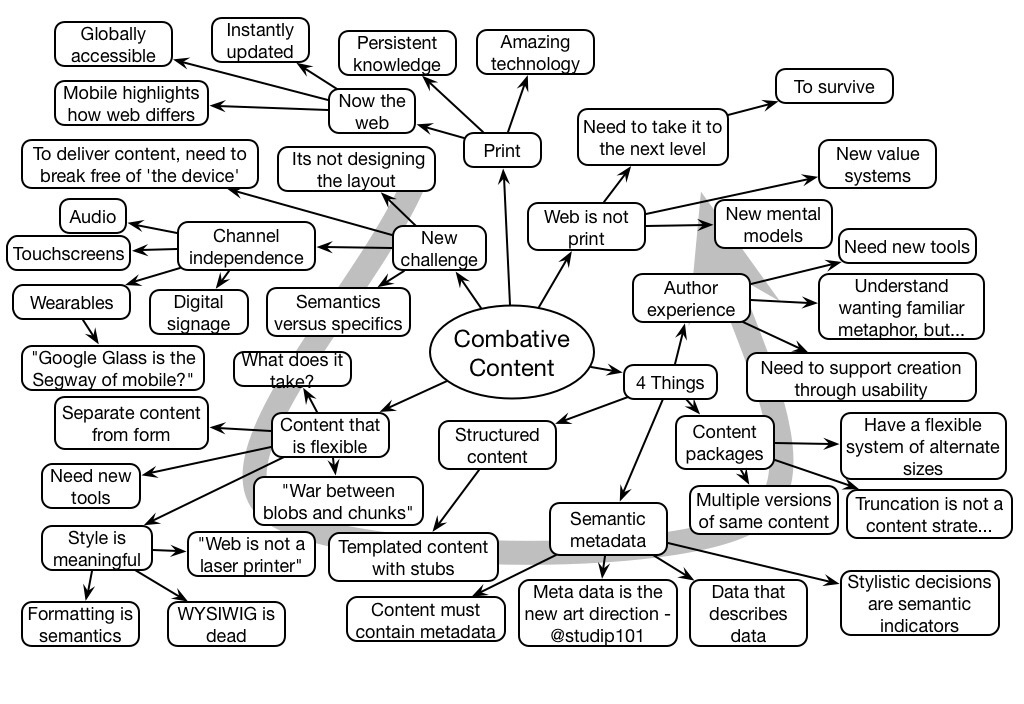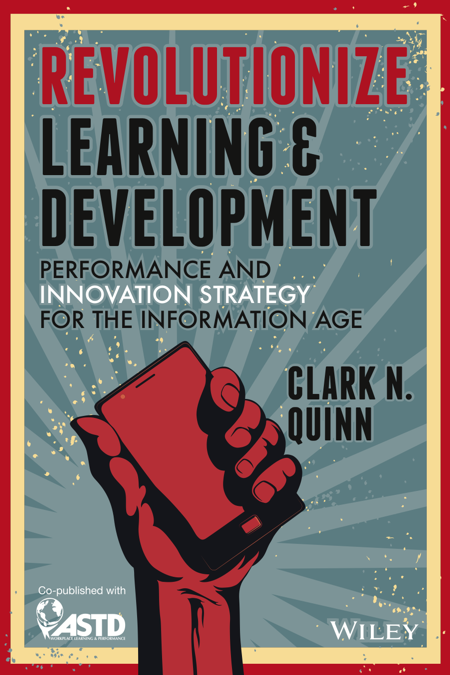The eLearning Guild is celebrating it’s 10th year, and is using the opportunity to reflect on what learning will look like 10 years from now. While I couldn’t participate in the twitter chat they held, I optimistically weighed in: “learning in 2024 will look like individualized personal mentoring via augmented reality, AI, and the network”. However, I thought I would elaborate in line with a series of followup posts leveraging the #lrn2024 hashtag. The twitter chat had a series of questions, so I’ll address them here (with a caveat that our learning really hasn’t changed, our wetware hasn’t evolved in the past decade and won’t again in the next; our support of learning is what I’m referring to here):
1. How has learning changed in the last 10 years (from the perspective of the learner)?
I reckon the learner has seen a significant move to more elearning instead of an almost complete dependence on face-to-face events. And I reckon most learners have begun to use technology in their own ways to get answers, whether via the Google, or social networks like FaceBook and LinkedIn. And I expect they’re seeing more media such as videos and animations, and may even be creating their own. I also expect that the elearning they’re seeing is not particularly good, nor improving, if not actually decreasing in quality. I expect they’re seeing more info dump/knowledge test, more and more ‘click to learn more‘, more tarted-up drill-and-kill. For which we should apologize!
2. What is the most significant change technology has made to organizational learning in the past decade?
I reckon there are two significant changes that have happened. One is rather subtle as yet, but will be profound, and that is the ability to track more activity, mine more data, and gain more insights. The ExperienceAPI coupled with analytics is a huge opportunity. The other is the rise of social networks. The ability to stay more tightly coupled with colleagues, sharing information and collaborating, has really become mainstream in our lives, and is going to have a big impact on our organizations. Working ‘out loud’, showing our work, and working together is a critical inflection point in bringing learning back into the workflow in a natural way and away from the ‘event’ model.
3. What are the most significant challenges facing organizational learning today?
The most significant change is the status quo: the belief that an information oriented event model has any relationship to meaningful outcomes. This plays out in so many ways: order-taking for courses, equating information with skills, being concerned with speed and quantity instead of quality of outcomes, not measuring the impact, the list goes on. We’ve become self-deluded that an LMS and a rapid elearning tool means you’re doing something worthwhile, when it’s profoundly wrong. L&D needs a revolution.
4. What technologies will have the greatest impact on learning in the next decade? Why?
The short answer is mobile. Mobile is the catalyst for change. So many other technologies go through the hype cycle: initial over-excitement, crash, and then a gradual resurgence (c.f. virtual worlds), but mobile has been resistant for the simple reason that there’s so much value proposition. The cognitive augmentation that digital technology provides, available whenever and wherever you are clearly has benefits, and it’s not courses! It will naturally incorporate augmented reality with the variety of new devices we’re seeing, and be contextualized as well. We’re seeing a richer picture of how technology can support us in being effective, and L&D can facilitate these other activities as a way to move to a more strategic and valuable role in the organization. As above, also new tracking and analysis tools, and social networks. I’ll add that simulations/serious games are an opportunity that is yet to really be capitalized on. (There are reasons I wrote those books :)
5. What new skills will professionals need to develop to support learning in the future?
As I wrote (PDF), the new skills that are necessary fall into two major categories: performance consulting and interaction facilitation. We need to not design courses until we’ve ascertained that no other approach will work, so we need to get down to the real problems. We should hope that the answer comes from the network when it can, and we should want to design performance support solutions if it can’t, and reserve courses for only when it absolutely has to be in the head. To get good outcomes from the network, it takes facilitation, and I think facilitation is a good model for promoting innovation, supporting coaching and mentoring, and helping individuals develop self-learning skills. So the ability to get those root causes of problems, choose between solutions, and measure the impact are key for the first part, and understanding what skills are needed by the individuals (whether performers or mentors/coaches/leaders) and how to develop them are the key new additions.
6. What will learning look like in the year 2024?
Ideally, it would look like an ‘always on’ mentoring solution, so the experience is that of someone always with you to watch your performance and provide just the right guidance to help you perform in the moment and develop you over time. Learning will be layered on to your activities, and only occasionally will require some special events but mostly will be wrapped around your life in a supportive way. Some of this will be system-delivered, and some will come from the network, but it should feel like you’re being cared for in the most efficacious way.
In closing, I note that, unfortunately,my Revolution book and the Manifesto were both driven by a sense of frustration around the lack of meaningful change in L&D. Hopefully, they’re riding or catalyzing the needed change, but in a cynical mood I might believe that things won’t change near as much as I’d hope. I also remember a talk (cleverly titled: Predict Anything but the Future :) that said that the future does tend to come as an informed basis would predict with an unexpected twist, so it’ll be interesting to discover what that twist will be.


